A poster summarising this project as per March 2017 can be downloaded here. It may be used and reproduced freely, provided it is not changed.
Final Report April 2020
Koi carp as a fertiliser for coastal dune planting
Introduction
 Over a 3-year period the Coastal Restoration Trust in collaboration with the Waikato Regional Council and Coastcare groups have been evaluating a range of options for using the pest fish koi carp in community-based restoration programmes. The project was partially funded by the Ministry for the Environment’s Community Environment Fund.
Over a 3-year period the Coastal Restoration Trust in collaboration with the Waikato Regional Council and Coastcare groups have been evaluating a range of options for using the pest fish koi carp in community-based restoration programmes. The project was partially funded by the Ministry for the Environment’s Community Environment Fund.
 Koi carp are an invasive pest fish thought to have been imported into New Zealand accidentally in the 1960s. Numbers have exploded in the rivers and lakes of the lower Waikato basin over the last 3 decades where they cause catastrophic habit loss for native fauna and flora and have a detrimental effect on water quality.
Koi carp are an invasive pest fish thought to have been imported into New Zealand accidentally in the 1960s. Numbers have exploded in the rivers and lakes of the lower Waikato basin over the last 3 decades where they cause catastrophic habit loss for native fauna and flora and have a detrimental effect on water quality.
The Waikato Regional Council have been exploring the potential for a Carp-N Neutral project aimed at trapping carp and “digesting” them into fertiliser and other products to benefit environmental programmes. Fish traps screen carp and other pest fish including catfish while allowing smaller native species to pass through unharmed.
The focus of this project has been on testing koi carp derived fertiliser as an alternative to commercially available synthetic fertiliser widely used by Coastcare groups nationwide to boost planted native seedlings as part of coastal restoration programmes. Preliminary investigation of other potential uses has included evaluating processed koi carp as animal repellents for newly planted natives to reduce browsing damage, as a lure for predator control programmes, and as an alternative fertiliser additive in nursery propagation of natives.
Establishment of dune planting trials
Coastcare planting programmes involving planting of the key native sand binders spinifex and pingao on foredunes use slow release fertiliser tablets or pellets to provide an initial boost in growth. Tablets are preferred as they reduce the complication of measuring out a certain dose of fertiliser in pellet or granule form.
Over the three years of the project, trials were established at four sites on the western and eastern coasts of the Waikato region to compare performance of koi carp fertiliser with the commercially available fertiliser tablet. All trials were established in collaboration with council staff and local community Coastcare groups. The pelletised koi carp fertiliser had a lower nitrogen content than the 2 tablets so to ensure comparability in trials, 72g of fish pellets (a handful) is equivalent to a 10g fertiliser tablet. Trials used a randomised complete block design, with three of four replicates at each site.
Assessments undertaken 12 months after planting involved recording survival, measuring plant spread, and a subjective assessment of plant vigour based on colour and other effects like frost damage and insect or fungal attack. The score used were 1 = poor, 2 = unthrifty, 3 = average, 4 = good, and 5 = excellent.
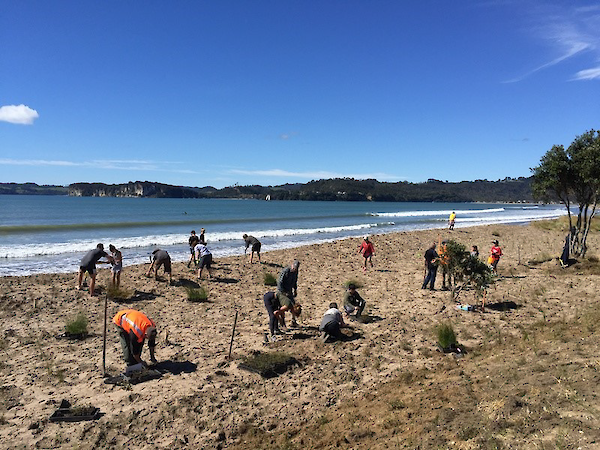 The local Buffalo Beach Coastcare group and staff from the Waikato Regional Council and Thames Coromandel District Council planting native foredune seedlings at Whitianga, Coromandel Peninsula, to compare koi carp fertiliser with the standard use of commercial slow release fertiliser tablets
The local Buffalo Beach Coastcare group and staff from the Waikato Regional Council and Thames Coromandel District Council planting native foredune seedlings at Whitianga, Coromandel Peninsula, to compare koi carp fertiliser with the standard use of commercial slow release fertiliser tablets
Promising alternative organic fertiliser
Koi carp fertiliser gave a similar response to the standard practice of commercial fertiliser tablets in boosting early growth of both pingao and spinifex. The results of the trials at Port Waikato are shown in the graphs and are similar to results from other sites although effect of rabbits at some sites and drought at the last site where backdune species were planted have resulted in overall poor performance not related to fertiliser.
While fencing was used to exclude rabbits and hares from browsing new seedlings at the Port Waikato site, fencing around at least one replicate was breached by substantial sand movement allowing temporary access by rabbits. Consequently, the more palatable pingao survival is lower than the spinifex when assessed 12 months after planting (Figure 1).
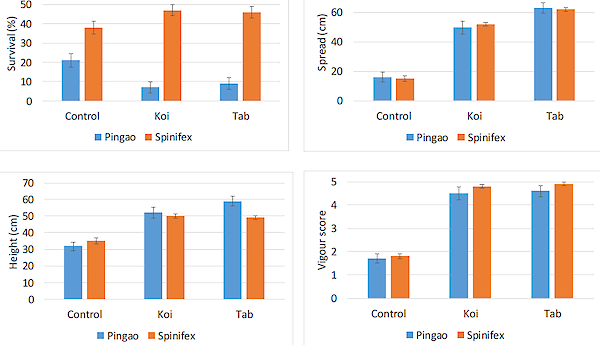 Figure 1: Mean survival, plant spread, height and plant vigour score for pingao and spinifex 12 months after planting at Port Waikato coastal dune trial. These results were similar across three other planting sites indicating koi carp fertiliser give similar boost to growth of sand binders to commercially available tablet slow release fertiliser. Growth response of both fertilisers were significantly greater than non-fertilised controlsMeasures of plant spread and plant vigour indicate that koi carp fertilise is giving a similar boost in growth compared to the fertiliser tablet and to a lesser extent for plant height (Figure 1).
Figure 1: Mean survival, plant spread, height and plant vigour score for pingao and spinifex 12 months after planting at Port Waikato coastal dune trial. These results were similar across three other planting sites indicating koi carp fertiliser give similar boost to growth of sand binders to commercially available tablet slow release fertiliser. Growth response of both fertilisers were significantly greater than non-fertilised controlsMeasures of plant spread and plant vigour indicate that koi carp fertilise is giving a similar boost in growth compared to the fertiliser tablet and to a lesser extent for plant height (Figure 1).
Interest in using pest fish
Participants at the annual Coastal Restoration Trust National Conferences during the 3 year project have consistently been enthusiastic about the potential to use koi carp fertiliser in their Coastcare planting programmes as an alternative to the standard commercial fertiliser options.
A survey undertaken during the project of potential users of koi carp as a fertiliser indicated favourably interest in using it as an alternative to commercially available slow release fertiliser. Of the numerous comments and feedback, most respondents indicated the smell was a distinctive factor but were not deterred from using koi carp pellets as a fertiliser for planting natives, especially if it could replace the use of artificial commercially prepared slow release options. In addition to smell, other major factors included continuity of supply given that it is a pest fish and perceived or real concerns with managing the resource verses any practical eradication options. Although the use of pest fish as fertiliser, predator baits and lures, nursery fertiliser and organic matter, or as a browsing deterrent was widely supported, the cost of the products was paramount for respondents, especially as many restoration programmes are community based and resource-limited.
Securing a sustainable supply
A sustainable supply of pest fish is highly likely to provide fertiliser and other products for environmental restoration. There are at least five or six other places where traps designed as mobile units could be set up in the lowland Waikato, let alone in other regions where koi carp are breeding to help provide a sustainable supply of koi carp. The Bowhunters Club in the Waikato have an annual competition catching koi carp and end up with nearly 10 tonnes of fish that they have limited use for. There is scope to set up a central processing facility and have carp from multiple trapping sites to provide a sustainable supply of digested material that can be economically viable for supporting community-based restoration programmes.
While every opportunity should be explored to eradicate pest fish from our waterways, this is not likely to occur with the major infestations of the larger waterbodies or the Waikato river systems in the near future. Hence it is highly likely a supply of pest fish from ongoing control programmes aimed at reducing numbers and the negative impact on the environmental, social and cultural values will be self-sustaining with a secure ongoing supply of carp fish for processing to meet ongoing demand from community groups. This has ongoing economic benefits for environmental restoration programmes as fertiliser for planting of natives with the advantages of providing organic based products compared to petrochemical derived fertiliser options.
In a paper by David et al. (2018) that included results from this project and the work of Waikato Regional Council’s CarP- N neutral Project, evidence from elsewhere in the Southern Hemisphere where invasive fish harvest has been commercialised suggests that while temporary reductions in catch may occur within a given waterbody subject to intensive harvest, the wider population recovers rapidly once harvest pressure is reduced. Furthermore, there is a clear indication that harvest pressure can reduce invasive fish biomass and therefore contribute to localised improvement in conservation outcomes along with other restoration initiatives such as riparian planting.
This project has demonstrated that there is an opportunity to utilise pest fish as an organic fertiliser where there is likely to be a sustainable supply using a network of mobile traps to reduce the impact on waterways throughout parts of the lower Waikato river and lake system. Further work is required to undertake an analysis of the practicality of setting up a capture and processing facility to supply koi carp fertiliser in consultation with government agencies, iwi and the wider community.
David et al (2018) also argues that the running costs for supply and use of koi carp as a fertiliser could be recovered with an increased scale of operations. However, the paper also acknowledges that commercialisation of such pest animals can result in maintaining populations or incentivising further spread resulting in potential environmental loss than gain. Clearly, a business case for developing a sustainable supply of pest fish will need to take account of these major issues to ensure there are net environmental benefits.
Other opportunities
Preliminary investigation as part of this project has also shown other potential uses for processed pest fish products in conservation projects, as both liquid and solid forms.
Predator lure/bait Table 1: Documented kills from the predator trapping programme at the National Wetlands Centre undertaken in conjunction with the New Zealand Landcare Trust. Data are from a 9 month trapping period comprising records from 50 DOC 250 traps (adapted from David et al. 2018)
Table 1: Documented kills from the predator trapping programme at the National Wetlands Centre undertaken in conjunction with the New Zealand Landcare Trust. Data are from a 9 month trapping period comprising records from 50 DOC 250 traps (adapted from David et al. 2018)
Initial investigation has indicated that digested koi carp product could be used for animal predator lures and baits. As reported in David et al. (2018), a line of 50 kill traps (DOC 250’s) were established around the perimeter of the National Wetlands Centre at Miranda, south of Auckland. A combination of egg and rabbit or koi carp pellet baits were placed in alternating kill traps by a local conservation community group. Traps were checked approximately monthly by volunteers and results of any kills documented and reported.
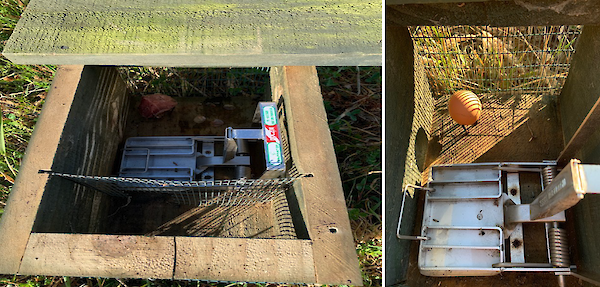 A koi carp baited trap (left) and an egg bait trap (right) ready for settingAfter 9 months of trapping the traps set with koi carp pellets had trapped a greater number of rats and hedgehogs compared to the 25 traps set with rabbit/egg (Table 1). Conversely rabbit/egg baits trapped a greater number of mustelids than the koi carp baits.
A koi carp baited trap (left) and an egg bait trap (right) ready for settingAfter 9 months of trapping the traps set with koi carp pellets had trapped a greater number of rats and hedgehogs compared to the 25 traps set with rabbit/egg (Table 1). Conversely rabbit/egg baits trapped a greater number of mustelids than the koi carp baits.
These results are encouraging where koi carp appears to be a promising alternative lure for predator control programmes. Further trials on testing koi carp including other processed options of the fish including the liquid product is required.
Foliage repellent
Pilot trials have indicated the effectiveness of koi oil which is the liquid condensate that is a by-product of the processing of the fish as a foliar spray to deter browsing of highly palatable planted natives by domestic stock and pest animals. The dark brown liquid which has a strong fish or sulphurous odour was applied to the foliage of planted seedlings by knapsack sprayer.
Trials compared a range different concentrations of koi carp liquid with a commercially based foliage protection product Treepel, and the use of resin. The resin mixed with the koi carp liquid condensate provide a “rain-fast” water-proof effect to extend the effectiveness of the deterrent to browsing when rain occurs. The commercially available egg and resin based product Treepel is widely available for use in restoration programmes where there are difficulties in reducing animal browsers to low numbers.
Nursery use for koi carp
Preliminary evaluation of koi carp fertiliser pellets for use as an additive to potting mixes in a commercial native plant nursery are not likely to provide any added benefits. Koi carp fertiliser pellets attract rodents, particularly mice which are a major factor in native plant propagation facilities, especially for seed storage, sowing and early germination stages, including highly palatable key native sand binders spinifex and pingao.
Commercial native plant nurseries are likely to be less interested in adopting koi carp as a fertiliser additive to potting mixes as these are commercially prepared in bulk and a substantial sustainable supply of koi carp would be required. However, there could be scope for community and iwi-based nurseries to use koi carp in organic based potting mixes in production of native plants.
Reference
David, B.; Özkundakci, D.; Pingram, M.; Bergin, D.; Bergin, M. 2018: “The CarP- N neutral Project”: Removal, processing and reuse of invasive fish in local terrestrial conservation projects. Journal of Applied Ecology 55:1567–1574.
April 2019 Update
 Introduction
Introduction
Year 2 of this Coastal Restoration Trust project jointly funded by the Ministry for the Environment’s Community Environment Fund, and project partners Waikato Regional Council and their Beachcare Programme, with input from community groups has been completed. Highlights have been the completion of a survey of potential users of processed captured koi carp products particularly in coastal restoration programmes, ongoing fertiliser trials on several Waikato coastal dunes, and collation of the economic, cultural and social benefits of managing koi carp in our waterways by reducing their impact and using fish for environmental programmes.
Survey of potential users
A survey was developed to determine the New Zealand coastal restoration community’s response to a variety of questions relating to use of invasive pest fish as products in environmental restoration programmes. The current project evaluating uses of products such as fertiliser made from the captured pest fish koi carp is attracting wide interest from those involved in restoring native vegetation communities on our degraded dune as well as other potential uses such as deterring browsing of newly planted natives, and as lures and baits in predator control programmes. Feedback from potential users would be useful in guiding future work and research.
A selection of questions covering current knowledge on the project, those interested in the work being undertaken and current methods within restoration programme’s around the country were included in a survey format. An online survey platform Survey Monkey was used to distribute the questions to a wide range of individuals, groups and organisations associated with the Coastal Restoration Trust of NZ, comprising over 100 coast care and other stakeholder group contacts. The survey was also promoted at the Coastal Restoration Trust’s National Conference held in March this year in Warkworth.
Of the 35 responses received from stakeholders, most were from local authorities, landowners, Coast Care groups and individuals. Over 70% of the respondents were already aware of the koi carp project underway and evaluation of options for use in coastal environmental restoration programmes. Most respondents were involved across many areas of restoration including planting on coastal sand dunes, wetlands, riparian zones and native forest and shrublands. A number of groups were also involved in pest animal control.
The dominant fertiliser formulation used in restoration planting programmes was the NPK slow-release fertiliser tablets that is incorporated in the pit during planting. There was unanimous interest in using koi carp as a fertiliser in environmental planting programmes with over 90% interest in using in predator control programmes as lures and baits, and over 80% interest in using koi carp liquid spray for protecting foliage of newly planted natives.
Of the numerous comments and feedback, most respondents indicated the smell was a distinctive factor but were not deterred from using koi carp pellets as a fertiliser for planting natives, especially if it could replace the use of artificial commercially prepared slow release options. In addition to smell, other major factors included continuity of supply given that it is a pest fish and perceived or real concerns with managing the resource verses any practical eradication options. Although the use of pest fish as fertiliser, predator baits and lures, nursery fertiliser and organic matter, or as a browsing deterrent was widely supported, the cost of the products was paramount for respondents, especially as many restoration programmes are community-based and resource-limited, along with the issue of a long term sustainable supply.
Progress with fertiliser trials
Coastal dune planting trials established at Port Waikato and Whitianga evaluating koi carp fertiliser were measured in full during Year 2 including photographed including for the first time using a UAV (drone) to assess survival and growth of planted plots. The Port Waikato trials comprised four replicates each with a fenced group and an unfenced group of 3 fertiliser treatment subplots.
Fencing was used to exclude rabbits and hares from browsing the new seedlings. It was constructed at the time of planting.
Fertiliser treatments were one standard commercial slow release fertiliser tablet, one measure of koi carp pellets (the equivalent amount of nitrogen was matched to the commercial slow release tablet fertiliser) and a control (no fertiliser) applied at the time of planting. Two species were planted spinifex (Spinifex sericeus) and pingao (Ficinia spiralis). A full re-measurement was completed for the one year old plantings.
 Survival
Survival
Of the two native sand binders planted on the foredunes spinifex had better survival than pingao on average across the range of treatments (refer to Figure 1 for a comparison of treatments for pingao and spinifex). Fenced plots had better survival than unfenced plots indicating rabbits were continuing to be a significant problem with browsing, especially the highly palatable pingao - unfenced pingao suffered from browsing early on and show this with the lower survival rates. The rate of 80-90% survival for spinifex across all fertiliser treatments and the control is consistent with other fertiliser trials. The trials at Port Waikato and Whitianga show that koi carp fertiliser has been equally effective in maintaining high survivals as the standard fertiliser method of using a slow release NPK Agpro tablet.
Height
Pingao have achieved higher growth than spinifex which is reflected across the height measurements from each treatment (refer to Figure 2 for height growth of planted sand binders for all treatments). As expected the control plots (no fertiliser) are shorter on average than the tablet and koi fertiliser plots. Koi carp fertiliser pellets have performed as well as the standard tablet fertiliser treatment.
Vigour
Vigour is a measure of the plants visual health based on colour and other noted effects like frost damage and insect or fungal attack. The score is rated 0 = dead, 1 = very poor, 3 = average and 5 = excellent (refer to Figure 3 for plant vigour scores for the native sand binders).
High vigour scores were recorded across all the tablet and koi fertiliser treatments however unfenced tablet pingao was significantly lower reflecting the influence of browsing by rabbits. The control plots were significantly lower in vigour scores particularly within the unfenced control very poor.
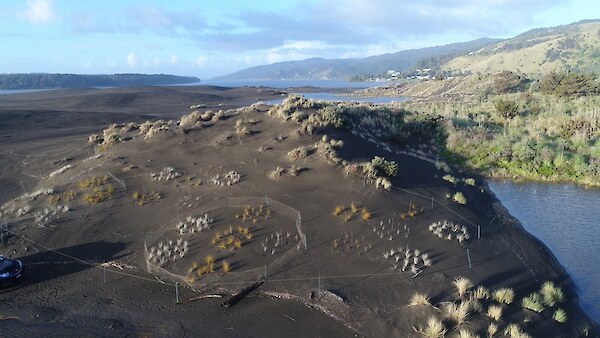 Overlooking the fertiliser trial site at Port Waikato shows replicate one with the fenced and unfenced groups
Overlooking the fertiliser trial site at Port Waikato shows replicate one with the fenced and unfenced groups
Preliminary conclusions
Koi carp fertiliser is proving to be as effective as a fertiliser treatment as the standard NPK tablet fertiliser widely used in restoration planting programme by Coastcare and Beachcare groups throughout New Zealand. As with the standard practice using slow release fertiliser tablets, the koi carp pellets are incorporated into the pits as the spinifex and pingao are planted. Approximately one small handful (72 g) of 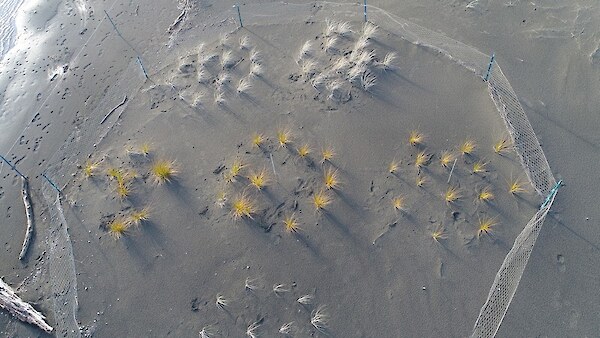 These photos (above and below) illustrate the use of new technology that will be developed to assess performance of planted natives in restoration programmes. The contrast between the sand and the planted sand binders will allow digital assessment of biomass by species and fertiliser treatment to supplement ground based measurements. The success of excluding rabbits by fencing (above) is in contrast to the lower biomass for planted seedlings without control of rabbits (below)koi carp pellets is use for each planted seedling delivering a similar rate of nitrogen. Control of rabbits in particular is essential for foredune planting so that performance of planted native sand binders can be maximised when boosted with the use of fertilisers at planting.
These photos (above and below) illustrate the use of new technology that will be developed to assess performance of planted natives in restoration programmes. The contrast between the sand and the planted sand binders will allow digital assessment of biomass by species and fertiliser treatment to supplement ground based measurements. The success of excluding rabbits by fencing (above) is in contrast to the lower biomass for planted seedlings without control of rabbits (below)koi carp pellets is use for each planted seedling delivering a similar rate of nitrogen. Control of rabbits in particular is essential for foredune planting so that performance of planted native sand binders can be maximised when boosted with the use of fertilisers at planting.
 The drone photographs show part of the Port Waikato planting site where each of the four replicates contained comprising 2 sets of 6 plots each, one fenced and one non-fenced to exclude rabbits which continue to be a major problem and are difficult to control. Each fenced and unfenced replicate block contained 3 plots of spinifex (light straw/green colour in photo) and 3 plots of pingao (distinctive yellow colour). The treatments included the koi carp and standard NPK slow-release tablet, and the clearly visible non-fertilised control where there is significantly less growth.
The drone photographs show part of the Port Waikato planting site where each of the four replicates contained comprising 2 sets of 6 plots each, one fenced and one non-fenced to exclude rabbits which continue to be a major problem and are difficult to control. Each fenced and unfenced replicate block contained 3 plots of spinifex (light straw/green colour in photo) and 3 plots of pingao (distinctive yellow colour). The treatments included the koi carp and standard NPK slow-release tablet, and the clearly visible non-fertilised control where there is significantly less growth.
Benefits of koi carp eradication programmes
Introduction
As described in a Waikato Times article (http://www.stuff.co.nz/waikato-times/life-style/people/8131705/Turning-the-orange-tide), there are a range of benefits, including economic, in exploring ways of utilising pest fish for environmental benefit.
North Waikato farmer and regional council chairman Peter Buckley first saw a koi carp in the early 1980s. Buckley, who has lived near Te Kauwhata for more than 60 years, has seen first-hand the damage inflicted on the river and lakes as carp numbers swelled:
“Prior to the koi carp, the water in the Whangamarino catchment would come clean. But because the fish stir up so much fine sediment when they feed, the water stays dirty. The fish also damage our stopbanks and drainage systems by burrowing into the banks to feed. The financial cost is potentially huge.”
A sustainable supply of pest fish is highly likely to provide fertiliser and other products for environmental restoration that will reduce cost of alternatives. There are at least five or six other places where traps designed as mobile units could be set up in the lowland Waikato, let alone in other regions where koi carp are breeding. The Bowhunters Club in the Waikato have an annual competition catching koi carp and end up with nearly 10 tonnes of fish that they have limited use for. There is scope to set up a central processing facility and have carp from multiple trapping sites to provide a sustainable supply of digested material that can be economically viable for supporting community based restoration programmes.
The nutrient-rich material from processed pest fish can not only supplement commercial fertiliser in coastal restoration programmes as a cost-effective alternative, but there are other potential economic benefits in use of koi carp and other pest fish to supplement commercial uses including compost for plant propagation, baits and lures for predator control, and as browsing deterrents for newly planted palatable native seedlings. This is also in addition to the positive impact of offsetting cost of pest fish in the waterways such as silting and damage to infrastructure.
This work led by Dr Bruno David, Freshwater Scientist of Waikato Regional Council, is a key collaborator in the Coastal Restoration Trust trials. Evaluating the economic and other benefits of utilising pest fish in environmental restoration programmes in this progress update will be available in more detail in a journal paper in press - David, B.O., Özkundakci, D., Pingram, M.A., Bergin, D. and Bergin, M. The CarP-N neutral Project: Removal and environmentally ethical processing and re-use of invasive fish in local terrestrial conservation projects.
Fertiliser
Standard commercial slow release fertiliser in tablet form used in restoration planting containing approximately 14-20% nitrogen and other elements at lower rates. Tablets are the preferred form as it reduces the complication of measuring out a certain dose of fertiliser in pellet or granule form.
While the scale of our dune planting trials is relatively small to date, annual nursery propagation of sand-binding dune plants in New Zealand is estimated to be around 250,000 plants. If each of these plants was provided with 72g fish pellets, approximately 18 tonnes of invasive fish fertiliser (equivalent to approximately 40 tonnes of processed wet weight fish) could be repositioned into dunes annually potentially replacing approximately 2.5 tonnes of artificial fertiliser tablets.
Animal repellents to protect planted natives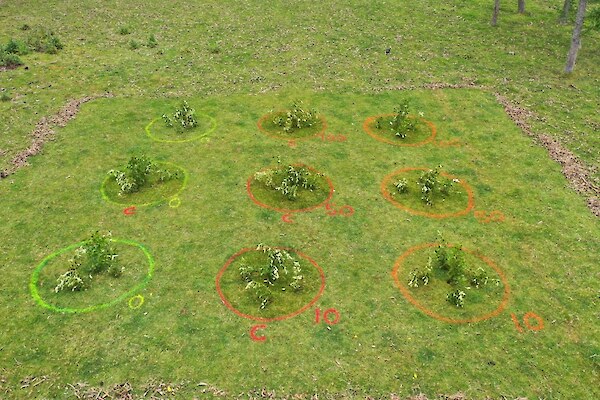 Test plots with treatments applied before grazing. Left row (yellow); control (no koi), middle row (red); koi repellent and crop oil and right row (orange); koi repellent only.
Test plots with treatments applied before grazing. Left row (yellow); control (no koi), middle row (red); koi repellent and crop oil and right row (orange); koi repellent only.
One of the major factors in mortality or poor early performance in restoration planting programmes is browsing by hares, rabbits, deer, goats and any feral domestic stock. While control programmes are highly recommended before planting of natives, there can be major issues in achieving full control so some browsing can still occur, especially as recently planted nursery-raised natives are favoured targets.
Preliminary animal repellent trials reported in the previous milestone indicates that the liquid extract from the digested koi carp, even when diluted to 10% with water, is proving effective in deterring browsing. Cost is likely to be minimal as the liquid extract is a by-product of the digestion process for the koi carp used in providing fertiliser.
Lures and baits in pest animals control programmes
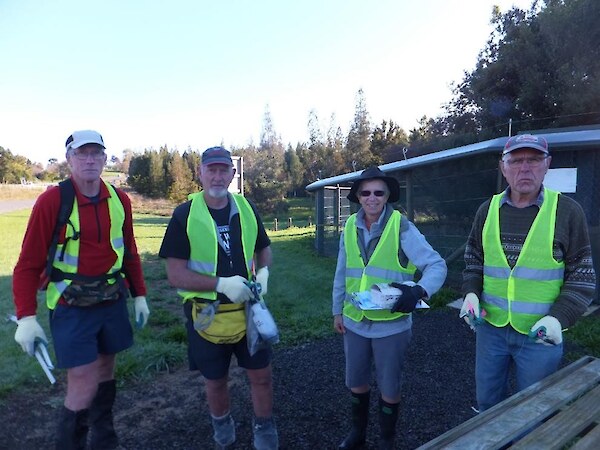 Volunteers at the National wetlands centre ready to deploy invasive fish and rabbit based baits to terrestrial DOC 250 kill traps. Photo courtesy of Nardene Berry (New Zealand Landcare Trust)Protein-based baits are typically used as lures for terrestrial pest control programmes. In particular, introduced mustelids (stoat Mustela erminea, weasel M. nivalis, ferret M. furo), feral cat (Felis catus), rat species (Norway rat Rattus norvegicus, ship rat R. rattus), house mouse (Mus musculus) and European hedgehog (Erinaceus europaeus), are the primary targets for protein-based lures. Currently, the most effective lure is considered to be a commercially-available rabbit-based product (‘Erayz’, Connovations, NZ, C. Gillies pers comm.) that is typically deployed by conservation groups in kill traps. Chicken eggs are often used in tandem with rabbit jerky as an additional visual lure for mustelids.
Volunteers at the National wetlands centre ready to deploy invasive fish and rabbit based baits to terrestrial DOC 250 kill traps. Photo courtesy of Nardene Berry (New Zealand Landcare Trust)Protein-based baits are typically used as lures for terrestrial pest control programmes. In particular, introduced mustelids (stoat Mustela erminea, weasel M. nivalis, ferret M. furo), feral cat (Felis catus), rat species (Norway rat Rattus norvegicus, ship rat R. rattus), house mouse (Mus musculus) and European hedgehog (Erinaceus europaeus), are the primary targets for protein-based lures. Currently, the most effective lure is considered to be a commercially-available rabbit-based product (‘Erayz’, Connovations, NZ, C. Gillies pers comm.) that is typically deployed by conservation groups in kill traps. Chicken eggs are often used in tandem with rabbit jerky as an additional visual lure for mustelids.
Preliminary results after 9 months of trapping suggest that the invasive fish baits are attractive to terrestrial pests, in particular rats and hedgehogs, for which fish bait performs as well or better than the rabbit and egg based baits currently used. Development of baits from the koi carp are still under development but squares cut from pest fish that are salted and/or dried are able to be used on some traps. In addition, the particularly pungent liquid extract from the digestion process of koi carp is being tested as a lure sprayed around traps to lure in predators.
Wider economic benefits of controlling pest fish
The CarpN Neutral programme provided a fish disposal service for the New Zealand Bowhunters Society at the annual “Koi Carp Classic’ (http://www.nzbowhunters.nz/events/koi-carp-classic/) where approximately 5 tonnes of invasive fish were harvested from the river by members during the event. These fish were then processed into pellets and later used in regional dune restoration planting.
The general philosophy of the CarpN-neutral project has been to use invasive species products for addressing other conservation problems rather than more typically creating products that directly benefit human consumption or use. Whether used as an alternative fertiliser, or as a complementary lure in terrestrial pest control, the material has a low footprint and the products are likely to be organically certifiable.
General information about koi carp and the damage they do, where they are found and their legal designation is provided by the Department of Conservation (https://www.doc.govt.nz/nature/pests-and-threats/animal-pests/fish/koi-carp). A radio interview by Alison Balance Radio New Zealand with Dr Bruno David from Waikato Regional Council discussing the Carp-N Neutral project and includes images of the projects activities (https://www.radionz.co.nz/national/programmes/ourchangingworld/audio/201793262/carpn-neutral-doing-good-things-with-bad-koi-carp). General information on koi carp and its known and predicted distribution in New Zealand. Also presents results on the penetration of koi carp in relation to altitude and distance up rivers by NIWA (https://www.niwa.co.nz/our-science/freshwater/tools/fishatlas/species/fish-species/koi_carp)
The economic cost of koi carp in waterways of our productive lands such as the rivers, streams, drainage networks and lakes of the lower Waikato are difficult to quantify. They are now widespread in Auckland and Waikato regions and are spreading into Northland, southern North Island and Nelson/Marlborough (although some control options are being explored for smaller water bodies to determine if eradication is practical). Numbers have exploded in the rivers and lakes of the lower Waikato basin over the last 3 decades where they cause catastrophic habit loss for native fauna and flora and have a detrimental effect on water quality. Calculating the economic cost of what must be significantly reduced recreation and tourism through poorer water quality has not been done.
Conclusions
This project demonstrates a practical, humane method of capturing and processing pest invasive fish that provides positive economic outcomes as well as environmental, social and cultural benefits for community groups dedicated to restoration of our degraded ecosystems. By doing this we won’t solve the carp issue but it’s the first step in a strategic framework to tackle the negative effects of carp by significantly reducing its numbers and potentially providing a range of products and uses to benefit environmental restoration across a range of ecosystems as well as providing economic incentives to upscale and maintain a pest fish control programme.
An analysis of the economics of using products made from digested pest fish has shown that koi carp derived fertiliser and animal predator lures and baits can be produced at significantly lower cost than commercially available products. While every opportunity should be explored to eradicate pest fish from our waterways, this is not likely to occur with the major infestations of the larger waterbodies or the Waikato river systems in the near future. Hence it is highly likely a supply of pest fish from ongoing control programmes aimed at reducing numbers and the negative impact on the environmental, social and cultural values will be self-sustaining with a secure ongoing supply of carp fish for processing to meet ongoing demand from community groups. This has ongoing economic benefits for environmental restoration programmes, both as fertiliser for planting of natives, and as bait and lures for animal predator control programmes at lower cost. In addition for fertiliser uses, there are the advantages of providing organic based products compared to petrochemical derived fertiliser options.
April 2018 Update
 The Waikato Regional Council and Coastal Restoration Trust are evaluating the use of digested koi carp in a range of products for positive environmental gains in community-based restoration initiatives. This projects has been funded by the Ministry for the Environment’s Community Environment Fund with support from Waikato Regional Council, local community Beach Care groups, and Coastal Restoration Trust research partners. This has included ongoing evaluation of digested koi carp as an organic fertiliser option for boosting performance of the native plants on dunes as part of dune restoration programmes:
The Waikato Regional Council and Coastal Restoration Trust are evaluating the use of digested koi carp in a range of products for positive environmental gains in community-based restoration initiatives. This projects has been funded by the Ministry for the Environment’s Community Environment Fund with support from Waikato Regional Council, local community Beach Care groups, and Coastal Restoration Trust research partners. This has included ongoing evaluation of digested koi carp as an organic fertiliser option for boosting performance of the native plants on dunes as part of dune restoration programmes:
- Incorporating koi carp pellets within the planting hole during planting;
- Comparison with the current fertiliser practice at planting using a slow-release fertiliser tablet;
- Evaluating the effects on a range of species including the sand binders spinifex and pingao, and mid-dune species pohuehue and wiwi;
- Evaluation of seaweed-derived fertiliser formulations developed by AgriSea as pellets applied in combination with koi carp or on its own; and
- For pingao, fencing at the Port Waikato site to exclude rabbits which have been difficult to control and have compromised earlier trials.
 Initial post-planting survival assessment indicates favourable performance of the organic koi carp options as compared to the standard fertiliser regimes. A full first year assessment will be carried out this winter. Further fertiliser trial sites have been arranged for extending planting and fertiliser treatments.
Initial post-planting survival assessment indicates favourable performance of the organic koi carp options as compared to the standard fertiliser regimes. A full first year assessment will be carried out this winter. Further fertiliser trial sites have been arranged for extending planting and fertiliser treatments.
The digested carp produce several components and by-products including a dry powder that can be pelletized, a nutrient-rich liquid (fish juice), and a lower-nutrient condensate. Other potential uses for koi carp were presented to the Coastal Restoration Trust’s Annual Conference held in Petone in March 2018.
Planning is well underway in setting up trials to evaluate potential uses for various formulations of digested koi carp that could be used by community groups. The uses being investigated include:
- Animal repellent – applied to foliage of palatable planted natives to deter browsing by rabbits (single largest killer of natives on dunes!) and other feral animals, inadvertent grazing by stock.
- Rodent bait – rodents are attracted to digested carp so excellent scope to manufacture moulded bait and chew cards as lures for control operations targeting rodents and mustelids to reduce predation of roosting and nesting birds, native skinks and invertebrates, and loss of seed crops of threatened natives.
- Nursery propagation – early trials indicate digested koi carp is an excellent additive to potting mix in the propagation of native, also potential liquid fertiliser.
- Fungal and insect control – Various potential uses of condensate and fish juice in foliar protection of planted natives.
- Carbon/organic matter – preliminary investigation indicates bio-char from willows of the same waterways infested with carp can be mixed with digested koi carp to reduce the smell and boost carbon storage to mitigate expected impacts of climate change.
 Dr Bruno David of the Waikato Regional Council has led the publication of a paper in the Journal of Applied Ecology - “The CarP-N neutral Project”: Removal, processing and reuse of invasive fish in local terrestrial conservation projects (Bruno David, Deniz Özkundakci, Michael Pingram, David Bergin and Michael Bergin 2018).
Dr Bruno David of the Waikato Regional Council has led the publication of a paper in the Journal of Applied Ecology - “The CarP-N neutral Project”: Removal, processing and reuse of invasive fish in local terrestrial conservation projects (Bruno David, Deniz Özkundakci, Michael Pingram, David Bergin and Michael Bergin 2018).
The paper presents two studies. The first study is based on early results from the current dune fertiliser trials as part of this Coastal Restoration Trust project and describes the use of processed invasive fish as a replacement for imported synthetic fertiliser tablets. The second is the potential use of invasive fish material as a lure in trapping programmes to control other introduced pests (e.g. introduced rats and mustelids) which will be further evaluated as part of this project.
July 2017 Update
 We have been successful in obtaining funding from the Ministry for the Environment’s Community Environment Fund. This will ensure work and research into using this pestfish until April 2020. Read the news release.
We have been successful in obtaining funding from the Ministry for the Environment’s Community Environment Fund. This will ensure work and research into using this pestfish until April 2020. Read the news release.
Koi Carp - Turning a Pest Fish into an Environmental Gain
Koi carp (Cyprinus carpio) populations have exploded in fresh water systems of the lower Waikato sin ce introduction, contributing to poor water quality. The species is now officially classified under various central and local regulations and Acts as a ‘noxious fish’, an ‘unwanted organism’, and a ‘containment animal pest’. They are opportunistic omnivores eating a wide range of food including insects, fish eggs, juvenile fish of other species, and a diverse range of plants and other organic matter.
ce introduction, contributing to poor water quality. The species is now officially classified under various central and local regulations and Acts as a ‘noxious fish’, an ‘unwanted organism’, and a ‘containment animal pest’. They are opportunistic omnivores eating a wide range of food including insects, fish eggs, juvenile fish of other species, and a diverse range of plants and other organic matter.
Photos: Koi carp have exploded in number in the lower Waikato River basin. They grow to 75cm in length and weigh up to 10kg (top). Directing koi carp down a chute where they are sorted prior to digestion (bottom).
This Waikato Regional Council Carp-N Neutral project managed by freshwater scientist Dr Bruno David aims to trap large numbers of koi carp and “digest” them into a range of products. The fish trap screens carp and other pest fish such as catfish while allowing smaller native species such as eel and smelt to pass through unharmed.
The Waikato Regional Council and Coastal Restoration Trust have teamed up to evaluate the use of digested koi carp in a range of products for positive environmental gains in community-based restoration initiatives. These can be applied to a range of ecosystems - coastal dunes, riparian zones, wetlands, forest ecosystems. Potential uses of processed koi carp include:
- slow release fertiliser – replacing artificial fertiliser for planting on sand dunes
- animal repellent – applied to foliage of palatable planted natives to deter browsing
- rodent bait – as lures for control operations targeting rodents and mustelids
- nursery propagation – additive to potting mix and liquid fertiliser
- fungal and insect control – foliar protection of planted natives
- carbon/organic matter – mixed with bio-char from willows to boost carbon storage
This project promotes the concept of sustainability and traceability of “energy’’ flow within and between ecosystems – for instance, harvesting nutrients in pest fish and using this as an organic fertiliser replacing artificial petro-based fertilisers to boost planted natives on sand dunes.



